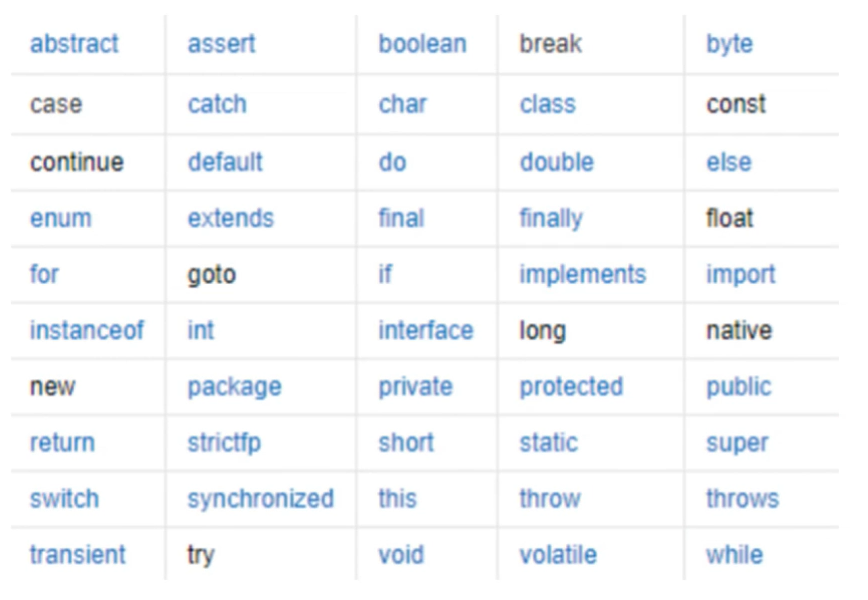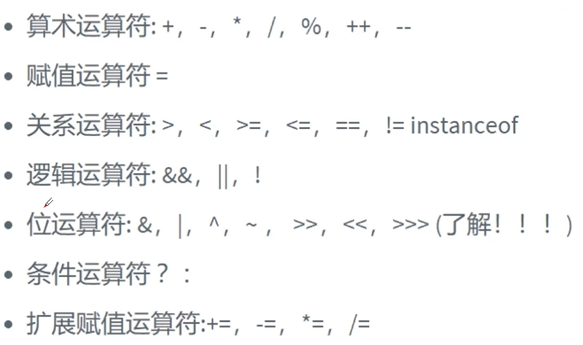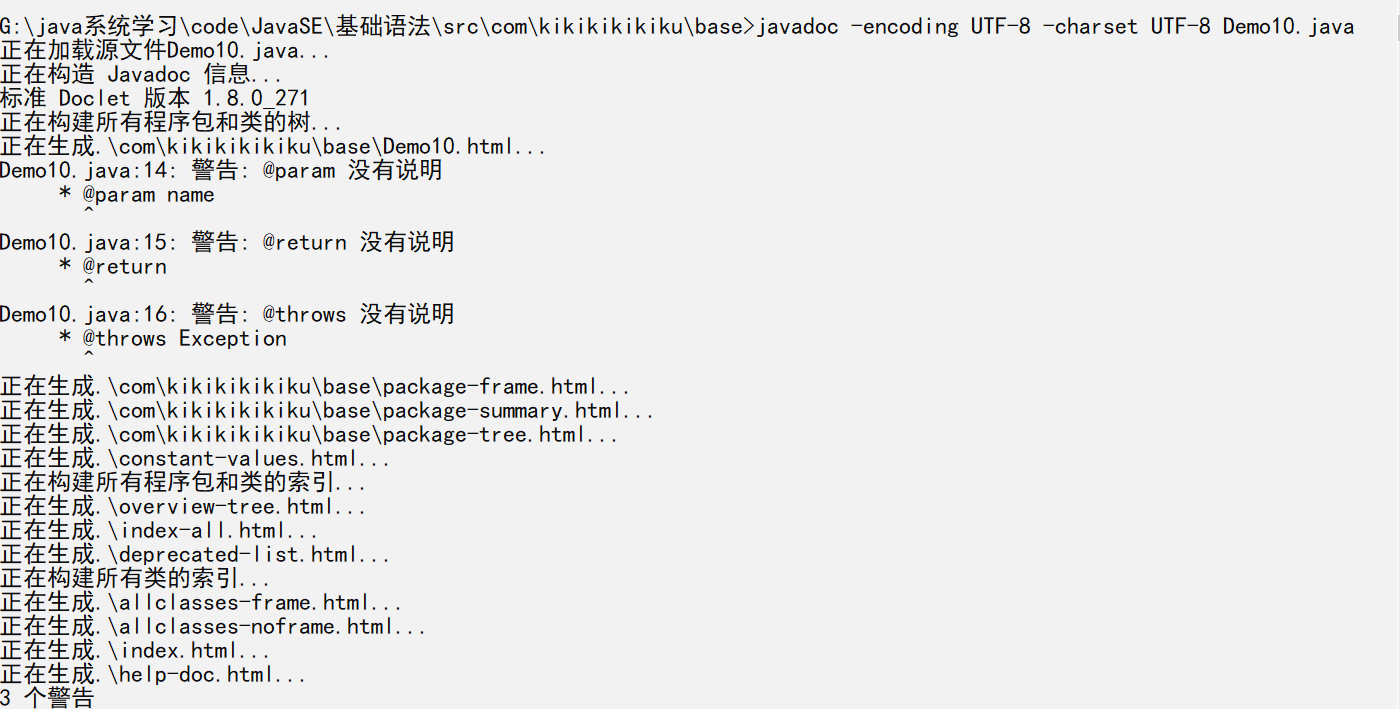Java基础
注释
public class Hello {
public static void main(String[] args) {
//单行注释
/*
多行注释
*/
/**
* 文档注释
*/
System.out.println("Hello,world");
}
}
标识符和关键字

-
所有标识符都应该以字母,美元符、下划线开始
-
首字母之后可以是字母、美元符、下划线或者数字的任何字符组合
-
不能使用关键字作为变量名或方法名
-
标识符是大小写敏感的
-
不建议用中文和拼音
数据类型
基本类型
public class Demo2{
public static void main(String[] args) {
//八大基本数据类型
//整数
int num1=10;
byte num2=20;
short num3=30;
long num4=39L;
//小数
float num5=39.1F;
double num6=3.1415926;
//字符
char name='中';
//字符串中String不是关键字,而是类
//布尔值
boolean flag = true;
boolean flag1 = false;
}
}
引用类型
类、接口、数组
数据类型扩展
import java.sql.SQLOutput;
public class Demo3 {
public static void main(String[] args) {
//整数拓展: 进制 二进制0b 十进制 八进制0 十六进制0x
int i = 10;
int i2 = 010;
int i3 = 0x10;
System.out.println(i);
System.out.println(i2);
System.out.println(i3);
System.out.println("===========================================================");
//============================================================
//浮点数拓展
//============================================================
//float 有限 离散 舍入误差 大约 接近但不等于
//double
//最好避免使用浮点数进行比较
float f = 0.1f;//0.1
double d = 1.0 / 10;//0.1
System.out.println(f == d);//false
float d1 = 23232323232323322f;
float d2 = d1 + 1;
System.out.println(d1 == d2);//true
//============================================================
//字符拓展
//============================================================
System.out.println("===========================================================");
char c1 = 'a';
char c2 = '中';
System.out.println(c1);
System.out.println((int) c1);
System.out.println(c2);
System.out.println((int) c2);
//所有的字符本质还是数字
//编码 Unicode 表:(97=a 65=A) 2字节 0-65536
//U0000 UFFFF
char c3 = '\u0061';
System.out.println(c3);//a
System.out.println("===========================================================");
//转义字符
//\t 制表符
//\n 换行
System.out.println("Hello\nWorld");
System.out.println("===========================================================");
//
String sa = new String("hello world");
String sb = new String("hello world");
System.out.println(sa == sb);
String sc = "hello world";
String sd = "hello world";
System.out.println(sc == sd);
//对象 从内存分析
/**
* 布尔值扩展
* boolean flag = ture;
* if (flag == ture) {}//新手
* if (flag) {}//老手
* Less is More! 代码要精简易读
*/
}
}
类型转换
Java是强类型语言,运算时的时候需要类型转换。

运算中,不同类型的数据先转换为同一类型,然后进行运算
public class Demo4 {
public static void main(String[] args) {
int i = 128;
byte b = (byte)i;
System.out.println(i);
System.out.println(b);
int a = 128;
float c = i;
System.out.println(a);
System.out.println(c);
//强制类型转换 由高到低
//自动类型转换 由低到高
/*
注意点:
1.不能对布尔值进行转换
2.不能把数据类型转换为不相干的类型
3.在把高容量转换到低容量的时候,进行强制转换
4.转换的时候可能存在内存溢出,或者精度问题!
*/
System.out.println("===============");
System.out.println((int)23.7);//23
System.out.println((int)-42.32f);//-42
System.out.println("===============");
char d = 'a';
int e = d+1;
System.out.println(e);
System.out.println((char)e);
}
}
public class Demo6 {
public static void main(String[] args) {
//操作比较大的数的时候,注意溢出问题
//JDK7新特性,数字之间可以用下划线分割
int money = 10_0000_0000;
int years = 20;
int total = money*years;//-147836480,计算的时候溢出了
long total2 = money*years;//默认是int,转换之前已经存在问题了
long total3 = money*((long)years);//先把一个数转换为Long
System.out.println(total3);
}
}
变量、常量、作用域
变量
变量:可以变化的量!
Java是一种强类型语言,每个变量都必须声明其类型。
Java变量是程序中最基本的存储单元,其要素包括变量名,变量类型和作用域。
type varName [=value][{,varName[=value]}];
//数据类型 变量名 = 值:可以使用逗号隔开来声明多个同类型变量。
public class Demo5 {
public static void main(String[] args) {
/*
为了程序的可读性一般不用这种
int a,b,c;
int a = 1;b=2;c=3;
*/
int a = 1;
int b = 2;
int c = 3;
String name = "xiaowei";
char x = 'Z';
double pi = 3.14;
}
}
-
注意事项:
-
每个变量都有类型,类型可以是基本类型,也可以是引用类型。
-
变量名必须是合法的标识符。
-
变量声明是一条完整的语句,因此每一个人声明都必须已分号结束。
变量作用域
类变量
实例变量
局部变量
public class Demo8 {
//类变量 static
static double salary = 2500;
//属性:变量
/*
实例变量:从属于对象:如果不自行初始化,这个类型的默认值为 0 0.0
布尔值:默认值是false
除了基本类型:其余的默认值都是null
*/
String name;
int age;
//main方法
public static void main(String[] args) {
//局部变量:必须声明和初始化
int i = 10;
System.out.println(i);
//变量类型 变量名字 = new Demo8();
Demo8 demo8 = new Demo8();
System.out.println(demo8.age);
System.out.println(demo8.name);
//类变量 static
System.out.println(salary);
}
//其他方法
public void add() {
}
}
常量
常量:初始化后不能再改变值!不会变动的值。
所谓常量可以理解成一种特殊的变量,它的值被设定后,在程序运行过程中不允许被改变。
//final 常量名 = 值;
final double PI = 3.14;
- 常量名一般使用大写字符。
public class Demo9 {
static final double PI = 3.14;
public static void main(String[] args) {
System.out.println(PI);
}
}
变量命名规范

运算符

public class Demo03 {
public static void main(String[] args) {
//关系运算符返回的结果:false,ture
int a =10;
int b = 20;
int c = 21;
//取余,模运算
System.out.println(c%a);// 21/10=2......1
System.out.println(a>b);
System.out.println(a<b);
System.out.println(a==b);
System.out.println(a!=b);
}
}
算术运算符
±*/
package operator;
public class Demo01 {
public static void main(String[] args) {
//二元运算符
int a = 10;
int b = 20;
int c = 25;
int d = 25;
System.out.println(a+b);
System.out.println(a-b);
System.out.println(a*b);
System.out.println(a/(double)b);
System.out.println("========================================");
a+=b;//a = a+b
a-=b;//a = a-b
System.out.println(a);
}
}
关系运算符
package operator;
public class Demo03 {
public static void main(String[] args) {
//关系运算符返回的结果:false,ture
int a =20;
int b = 10;
int c = 21;
//取余,模运算
System.out.println(c%a);// 21/10=2......1
System.out.println(a>b);
System.out.println(a<b);
System.out.println(a==b);
System.out.println(a!=b);
}
}
自增 自减 工具类
package operator;
public class Demo04 {
public static void main(String[] args) {
//++ -- 自增,自减 一元运算符
int a = 3;
int b = a++;//执行完这行代码后,先给b赋值,再自增
//a = a+1;
System.out.println(a);
//a = a+1
int c = ++a;//执行完这行代码前,先自增,再给b赋值
System.out.println(a);
System.out.println(b);
System.out.println(c);
//幂运算 2^3 2*2*2 = 8 很多运算,我们会使用一些工具类来操作
double pow = Math.pow(3,2);
System.out.println(pow);
}
}
逻辑运算符
package operator;
public class Demo05 {
public static void main(String[] args) {
//与(and) 或(or) 非(取反)
boolean a = true;
boolean b = false;
System.out.println("a && b:"+(a && b));//逻辑与运算:两个变量都为真,结果才为true
System.out.println("a || b:"+(a || b));//逻辑或运算:两个变量有一个为真,则结果才为true
System.out.println("a && b:"+!(a && b));//如果是真,则变为假,如果是假则变为真
//短路运算
int c = 5;
boolean d = (c<4)&&(c++<4);
System.out.println(d);
System.out.println(c);
}
}
位运算符
package operator;
public class Demo06 {
public static void main(String[] args) {
/*
A = 0011 1100
B = 0000 1101
A&B = 0000 1100
A|B = 0011 1101
A^B = 0011 0001 异或
~B = 1111 0010
2*8 = 16 2*2*2*2
效率极高!!!
<< *2
>> /2
0000 0000 0
0000 0001 1
0000 0010 2
0000 0011 3
0000 0100 4
0000 1000 8
0001 0000 16
*/
System.out.println(2<<3);
}
}
三元运算符
package operator;
//三元运算符
public class Demo07 {
public static void main(String[] args) {
//x ? y : z
//如果x == true,则结果为y,否则结果为z
int score = 50;
String type = score<60 ? "不及格" : "及格";//必须掌握
System.out.println(type);
}
}
包机制
-
为了更好地组织类,Java提供了包机制,用于区别类名的命名空间。
-
包语句的语法格式为:
package pkg1[.pkg2[.pkg3…]];
-
一般利用公司域名倒置作为包名;
-
为了能够使用某一个包的成员,我们需要在Java程序中明确导入该包。使用“import"语句可完成此功能
import package1[.package2...].(className|*);
JAVADOC
Javadoc命令是用来生成自己API文档的
-
参数信息
-
@author作者名
-
@version版本号
-
@since指明需要最早使用的jdk版本
-
@param参数名
-
@return返回值情况
-
@throws异常抛出情况
package com.kikikikikiku.base;
/**
* @author kikikikikiku
* @version 1.0
* @since 1.8
*/
public class Demo10 {
String name;
/**
* @author kikikikikiku
* @param name
* @return
* @throws Exception
*/
public String test(String name) throws Exception{
return name;
}
}

//-encoding UTF-8 编码为UTF-8
//-charset UTF-8 字符也为UTF-8






















 813
813











 被折叠的 条评论
为什么被折叠?
被折叠的 条评论
为什么被折叠?








